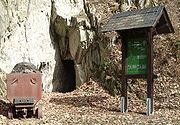
Slate is a fine-grained, foliated, homogeneous metamorphic rock derived from an original shale-type sedimentary rock composed of clay or volcanic ash through low grade regional metamorphism. The result is a foliated rock in which the foliation may not correspond to the original sedimentary layering. Slate is frequently grey in colour especially when seen en masse covering roofs. However, slate occurs in a variety of colours even from a single locality. For example slate from North Wales can be found in many shades of grey from pale to dark and may also be purple, green or cyan. Slate is not to be confused with shale, from which it may be formed, or schist.
Chemical composition
Slate is mainly composed of quartz and muscovite or illite, often along with biotite, chlorite, hematite, and pyrite and, less frequently, apatite, graphite, kaolin, magnetite, tourmaline, or zircon as well as feldspar. Occasionally, as in the purple slates of North Wales, ferrous reduction spheres form around iron nuclei, leaving a light green spotted texture. These spheres are sometimes deformed by a subsequent applied stress field to ovoids, which appear as ellipses when viewed on a cleavage plane of the specimen.
Uses
Slate in buildings
Slate can be made into roofing slates, also called roofing shingles, installed by a slater. Slate has two lines of breakability: cleavage and grain. This makes it possible to split slate into thin sheets. When broken, slate produces a natural appearance while remaining relatively flat and can be easily stacked. Silicone glue adheres to slate.
Slate tiles are often used for interior and exterior flooring, stairs, walkways, and wall cladding. Tiles are installed and set on mortar and grouted along the edges. Chemical sealants are often used on tiles to improve durability and appearance, increase stain resistance, reduce efflorescence, and increase or reduce surface smoothness. Tiles are often sold gauged, meaning that the back surface is ground for ease of installation. Slate flooring can however be slippery when used in external locations subject to rain. Slate tiles were used in 19th century UK building construction (apart from roofs) and in slate quarrying areas such as Bethesda there are still many buildings wholly constructed of slate. Slates can also be set into walls to provide a rudimentary damp-proof membrane. Small offcuts are used as shims to level floor joists. In areas where slate is plentiful it is also used in pieces of various sizes for building walls and hedges, sometimes combined with other kinds of stone.
Other uses
Because it is a good electrical insulator and fireproof, it was used to construct early 20th century electric switchboards and relay controls for large electric motors. Fine slate can also be used as a whetstone to hone knives.
Due to its thermal stability and chemical inertness, slate has been used for laboratory bench tops and for billiard table tops. In 18th and 19th century schools, slate was extensively used for blackboards and individual writing slates for which slate or chalk pencils were used. They were largely used in the 20th century, though writing slates were largely replaced by lined paper and notebooks, and slates still continue wide usage, though they are sometimes replaced with whiteboards.
Where slate of fine quality is available it is used for gravestones and commemorative tablets and by artists in various genres. British sculptor Stephen Kettle is notable for his use of slate to create statues housed in the Science Museum in London.
Slate is often used as a decor in freshwater aquariums. Slate will not alter the chemistry of water (except in the slate containing feldspar which may leach silicates into the water resulting in excess diatom growth in marine aquaria). Traditional Japanese Go equipment uses slate for the black pieces.
Slate extraction
In Eurasia
Slate-producing regions in Europe include Wales (see slate industry in Wales), Cornwall (famously the village of Delabole), and Cumbria (see Burlington Slate Quarries, Honister Slate Mine and Skiddaw Slate) in the United Kingdom; parts of France (Anjou, Ardennes, Bretagne, Savoie); Belgium (Ardenne); Liguria in northern Italy especially between the town of Lavagna (which means chalkboard in Italian) and Fontanabuona valley; Portugal especially around Valongo in the north of the country; Germany's (Moselle River-region, Hunsrück, Eifel, Westerwald, Thuringia and north-Bavaria); Alta, Norway (actually schist not a true slate) and Galicia. Some of the slate from Wales and Cumbria is colored slate (non-blue): (purple and formerly green in Wales) and (green in Cumbria). China has vast slate deposits; in recent years its export of finished and unfinished slate has increased: it has slate in various colors.
In the Americas
Slate is abundant in Brazil (the second biggest producer of slate) around Papagaio in Minas Gerais (responsible for 95% of the extraction of slate in Brazil), the east coast of Newfoundland, the Slate Belt of Eastern Pennsylvania, and the Slate Valley of Vermont and New York. The area around Granville, NY, is one place where colored slate (non-blue) is mined.
There was also a major slating operation in Monson, Maine during the late 19th and early 20th centuries. The slate found in Monson is usually a dark purple to blackish color, and many local structures are still roofed with slate tiles. The roof of St. Patrick's Cathedral was made of roofing slate from Monson, as was the headstone of John F. Kennedy.
Slate is also found in the Arctic and was used by the Inuit to make the blades for ulus.
From http://en.wikipedia.org/
Ear Force X41 (XBOX LIVE Chat + Wireless Digital RF Game Audio with Dolby
Headphone 7.1 Surround Sound)
-
Ear Force X41 (XBOX LIVE Chat + Wireless Digital RF Game Audio with Dolby
Headphone 7.1 Surround Sound)
by Turtle Beach
[image: Ear Force X41 (XBOX LIVE C...






0 comments:
Post a Comment